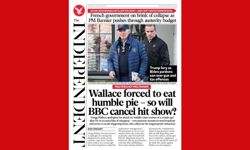Bluntness veering towards savagery was a prominent feature of newspaper journalism during the general election. It manifested itself on left and right of the spectrum. On May 7, the Daily Mirror demanded that voters send David Cameron packing and promised help from ‘Mirror Removals Service’, which claimed to specialise “in getting people out QUICKLY” and to be “fully-insured for broken promises”. If the message was not already stark, the Mirror lampooned Cameron with the promise, “we pack… you chillax!” and offered removals from Eton, Chipping Norton and Westminster. The Sun’s counterblast was a front page showing two bingo balls, one red showing 34% support for Labour and the other blue showing 34% for the Conservatives. The headline was “Well Hung” and below it in stark white on black, in case any readers harboured doubts about their newspaper’s preference: “Make sure YOU vote today to stop Labour ballsing up Britain.”
The Daily Mail weighed in with similarly unambiguous advice. Although its front page was dominated by the story of a mother ordered to surrender her baby to a gay couple, Associated Newspapers’ flagship did not waver from its true blue tradition. Below the masthead appeared another plea in white on black: “With one in four still undecided, make sure you use our tactical voting guide to keep Red Ed out”. The Daily Telegraph was only slightly more subtle. “Don’t do something you’ll regret”, it beseeched readers over an affectionate image of David and Samantha Cameron walking hand in hand.
’Twas ever thus
To several seasoned observers of the newspaper scene, this constituted evidence of a decline in standards. My old boss Andrew Neil tweeted that the election day front pages showed the “British press at its partisan worst: all pretence of separation between news and opinion gone, even in ‘qualities’”. Mr Neil’s point was fair, but it would be beyond foolish to imagine that he was describing an entirely recent development. Comparable partisanship has been apparent in newspaper coverage of general elections since the introduction of universal suffrage.
Many of us are familiar with the Sun’s front page of April 9 1992 in which Neil Kinnock’s head appeared inside a lightbulb alongside the warning: “If Kinnock wins today will the last person to leave Britain please turn out the lights.” Fewer recall the Zinoviev Letter, a notorious forgery alleging direct communist influence with which the Daily Mail undermined the Labour Party in 1924. Consider also the Daily Mirror of July 5 1945. It depicted a wounded soldier clutching a garland labelled “Victory and Peace in Europe”. The front page leader and headline instructed readers to vote Labour so as not to throw away what he had fought for. There was no pretence of balance there, or in the Daily Express which carried a front page picture of Winston Churchill with the headline “We Are Winning”.
In fact, Labour won that election winning 393 seats to the Conservatives’ 193 and making the Express’s front page blatant propaganda. Its proprietor, Lord Beaverbrook, was, of course, entirely unabashed. As he told the Royal Commission on the Press in 1947, “I run the paper purely for the purpose of making propaganda and with no other motive”.
So, any notion that newspapers have only recently acquired the habits of overt partisanship is nonsense. Less ludicrous is another modern criticism which was captured at the end of the 2015 campaign in a Twitter spat between former Mirror editor Piers Morgan and Peter Jukes, author of The Fall of the House of Murdoch. Jukes told Morgan: “The British press is only vibrant and diverse in the same way the Stasi was vibrant and diverse.” Morgan retorted: “Oh Peter, this is where you just sound very silly.” In his view, the British press remains the most diverse in the world. So, where does the truth lie?
Right leaning
Much has changed since 1945. Then 80% of families read one of the popular national dailies, the Daily Mail, Daily Mirror, Daily Express, News Chronicle and Daily Herald. And there was much greater balance in the mass market press. The Daily Mirror and Daily Herald offered Clement Attlee’s Labour Party firepower almost equal to that from the resolutely Conservative Daily Mail and Daily Express. Both the News Chronicle and the Manchester Guardian backed the Liberal Party. Only the Times, still tainted by its unwavering support for appeasement between 1937 and 1939, remained scrupulously neutral. Left of centre weeklies such as the New Statesman and Tribune had circulations they can only dream of today.
Today, consumption of printed newspapers is dominated by powerful and profitable right wing titles and the left objects strenuously. David Axelrod, the American political consultant who worked for Ed Miliband during the campaign, complained that Britain’s Conservative press is more powerful and “much more aggressive” than Fox News in America. Research conducted during the campaign by the Media Standards Trust sought to quantify part of this problem. It found that Rupert Murdoch’s Sun had displayed greater hostility to Ed Miliband in 2015 than to Neil Kinnock in 1992. Between 26 March and 3 May 2015, 77% of the News UK paper’s leaders were anti-Miliband, against 44% that were deemed anti-Kinnock in 1992.
Chasing sales
Plainly most readers choose right of centre newspapers. Unproven are the conclusions routinely drawn from this evidence; ie. that instinctively left of centre voters are being fooled into false consciousness by cunning capitalist proprietors, that stricter controls over newspaper ownership should be imposed to correct the imbalance and that right wing proprietors care more about ideology than profit. Rupert Murdoch’s enthusiasm for the SNP in Scotland hints at another explanation: that he cares about sales at least as much as he cares about supporting the Conservative Party. The Sun’s enthusiasm for Tony Blair between 1997 and 2005 illustrated the same point, as did the Daily Mail’s flirtation with Gordon Brown between 2005 and 2010. We should also note that the circulations of left wing newspapers fluctuated massively during the twentieth century, with Labour supporting titles growing very strong when readers wanted them, particularly during and immediately after WW2.
Clearly readers have deserted the Daily Mirror in droves since and the dear old Daily Herald is now the Sun. Equally clearly the left-leaning Guardian now exercises more influence online and in broadcast media than in print. But I find it hard to conclude that it therefore exercises less influence. The prominence of its excellent correspondents and columnists on radio and television suggests that it punches hard for its cause. Crucially, it also has power in the media that matter most.
Agenda setting
Research by Weber Shandwick and Research Now sought to identify the British electorate’s preferred sources of political information during the campaign. Television coverage was best at attracting attention, achieving top ranking among 56% of respondents. Newspapers came second with 44%. Asked about influence, respondents again identified television as most likely to affect their opinions. Social media came second with 40%, with press and radio each scoring 32%. Declining print circulations and expanded access to multichannel television and online news have diminished the power-broking role of newspapers. This, however, is a long way from meaning that they no longer matter.
Every journalist knows that broadcasters use newspapers as sources for stories. Amongst the examples of such agenda setting during the campaign was the Daily Telegraph’s story about 100 large businesses backing the Conservatives. This later led TV news bulletins. And newspaper influence is amplified by the impact of opinion polls. Polls such as YouGov in the Sunday Times and the Sun; ICM in the Guardian; ComRes in the Independent titles and Sunday Mirror and Ipsos Mori for the Evening Standard do not simply inspire comment in the newspapers themselves. They are included in the BBC’s poll of polls and debated on television. The extent to which their collective errors may have influenced voter behaviour in 2015 will occupy academics for years to come.
Add to this the influence exercised by newspaper journalists during election-related discussions on radio and television and it becomes plain that, though their printed circulations have declined and their profits with them, newspapers remain essential tools of Britain’s political and media class. Their influence extends beyond their own readerships and manifests itself throughout the media sphere.
During the 2015 campaign, every newspaper journalist who appeared on Sky News or the BBC’s Daily Politics or spoke to radio presenters such as LBC’s Nick Ferrari or BBC Radio’s Eddie Mair reminded us that newspaper journalism drives intelligent discourse. This symbiotic relationship between print and broadcast is equally pronounced in local journalism. Expert political editors such as the KM Group’s Paul Francis were pursued throughout the campaign by broadcasters who were often as keen to hear their wisdom as they were to interview candidates. Often they were keener. Political editors are not, after all, constrained by message discipline from party headquarters.
Comprehensive coverage
And Britain’s newspaper journalists delivered comprehensive coverage of the campaign. The broadsheets described and analysed policy, offered acres of incisive commentary and entertained with sparkling sketch writing. At the quality end of the mid-market, the Daily Mail did all of this and garlanded it with its distinctive brand of people-based reporting. I particularly enjoyed its two-page exploration of “Red Ed’s jolly tangled love life” (pages 12-13, Friday April 10) which was, of course, amply illustrated with pictures of high profile alleged former squeezes. Such reflection on politicians’ human foibles is not solely ideological in purpose; it makes politics interesting to readers who are bored by issue-based coverage.
I am not persuaded that newspapers swayed the outcome of our general election, but I am certain that a Conservative government in which the impressive John Whittingdale is secretary of state for media is unlikely to disrupt newspaper ownership. And I am supremely unconcerned. Newspapers covered the election brilliantly and demonstrated that plurality of ownership still delivers diverse coverage. My favourite examples: Marina Hyde of the Guardian produced unmissable work throughout. To be funny, wise and sophisticated once a week is an achievement. To do it day after day throughout an exhausting campaign is astonishing. Few can match Hyde’s coruscating genius as a sketch writer. My other favourite was The Independent Voter's Handbook, the title’s “daily miscellany celebrating the facts, figures and folklore of British general elections”. Such ideas often flag. This one remained valuable and entertaining throughout.












